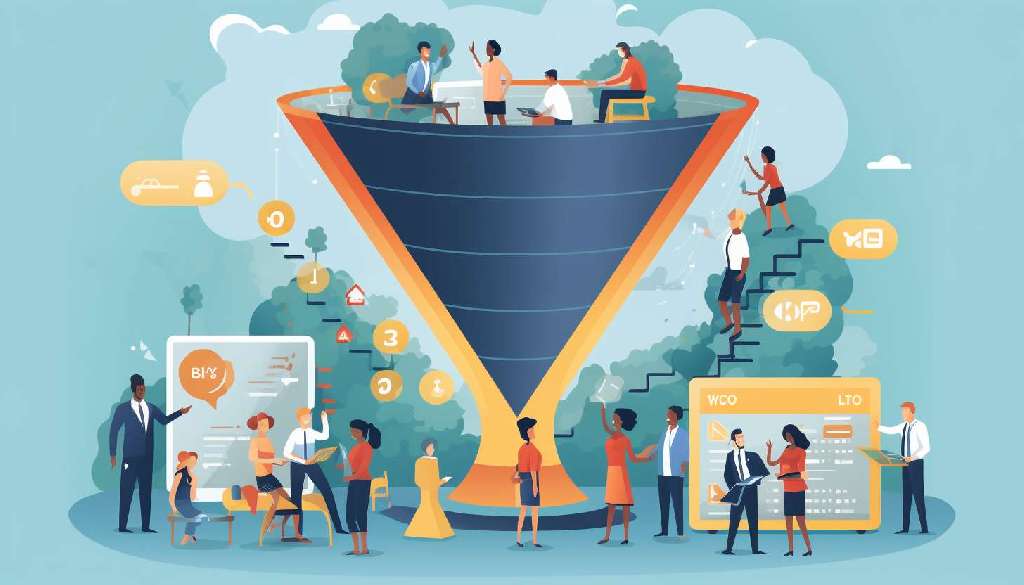Mastering the Conversion Funnel: The Key to Driving Sales in the US Market

Mastering the Conversion Funnel: The Key to Driving Sales in the US Market
The conversion funnel is the key to driving sales in today’s competitive market. Understanding its stages and how customers move through them is crucial for success. By optimizing the funnel, identifying leaks, and implementing effective strategies, businesses can dramatically improve their conversion rates. Collaboration between sales and marketing teams, leveraging influencer marketing, and exploring co-branding opportunities are some partnerships that can further enhance conversion funnel success. In this article, we will explore these topics and provide valuable insights for achieving optimal results.

What is a Conversion Funnel?
A conversion funnel is a fundamental concept in the world of marketing and sales. It refers to the journey that potential customers take from the initial point of contact to ultimately making a purchase or completing a desired action. By understanding the process of a conversion funnel, businesses can better analyze and optimize their marketing strategies to drive higher conversion rates and maximize revenue.
Stages of the Conversion Funnel
-
- Awareness: This is the first stage where customers become aware of a product or service. It involves capturing their attention and sparking interest through marketing efforts such as advertisements, social media campaigns, or blog posts.
- Interest: In the interest stage, customers show a deeper curiosity and actively seek more information about the product or service. This could involve researching reviews, comparing prices, or exploring product features.
- Desire: At this stage, customers have developed a strong interest in the product or service and begin to envision themselves owning or using it. They may have a desire to solve a problem or fulfill a need that the product or service can address.
- Action: The final stage is where customers take the desired action, such as making a purchase, subscribing to a service, or signing up for a newsletter. This is the ultimate goal of the conversion funnel.
Importance of Understanding the Conversion Funnel
Having a solid understanding of the conversion funnel is essential for businesses to effectively optimize their marketing strategies. By identifying and addressing any bottlenecks or weaknesses in each stage, companies can streamline the customer journey, increase conversion rates, and ultimately boost revenue.
Conversion Funnel Optimization
Conversion funnel optimization is a crucial aspect of driving successful sales and maximizing revenue. By identifying leaks in the funnel, implementing effective strategies, and tracking key metrics, businesses can improve their conversion rates and ultimately increase their bottom line.
Identifying Leaks in the Funnel
One of the first steps in conversion funnel optimization is to identify potential leaks or weaknesses at each stage of the funnel. This involves analyzing data and user behavior to pinpoint areas where potential customers are dropping off or losing interest.
Common causes of leaks in the funnel include complicated checkout processes, lack of trust signals, unclear call-to-actions, or irrelevant content. By conducting thorough analysis and testing, businesses can address these issues and streamline the user experience to minimize drop-offs and maximize conversions.
Strategies for Improving Conversion Rates
Once leaks in the funnel are identified, it’s time to implement strategies that will help improve conversion rates. Some effective strategies include:
-
- Optimizing Landing Pages: Crafting compelling and relevant landing pages tailored to each stage of the funnel can significantly impact conversion rates. Clear and persuasive messaging, compelling visuals, and user-friendly designs can all contribute to better conversion rates.
- A/B Testing: Testing different variations of elements on landing pages, such as headlines, call-to-actions, or images, can provide valuable insights into what resonates best with the target audience and drive higher conversions.
- Personalization: Tailoring the user experience based on customer data, such as demographics, past purchase behavior, or browsing history, can create a more personalized and engaging journey, boosting conversion rates.
- Social Proof: Incorporating customer testimonials, reviews, or case studies can help build trust and credibility, influencing purchasing decisions and improving conversion rates.
Conversion Funnel Metrics to Track
Tracking key metrics is essential for measuring the effectiveness of the conversion funnel and identifying areas for improvement. Some crucial metrics to track include:
-
- Conversion Rate: Calculating the percentage of visitors who convert into customers at each stage of the funnel provides insights into the overall funnel performance and helps identify areas that need attention.
- Abandonment Rate: Monitoring the number of users who abandon the funnel at different stages can reveal potential leaks or pain points that need to be addressed.
- Average Order Value: Understanding the average value of each customer’s purchase can help businesses optimize their pricing and upselling strategies to increase revenue.
- Time to Conversion: Analyzing the time it takes for a user to progress through the funnel can indicate any bottlenecks or delays that may impact conversion rates.
By closely monitoring these metrics and continuously optimizing the conversion funnel based on data-driven insights, businesses can drive higher conversion rates and achieve greater success in their online sales efforts.
Partnerships for Conversion Funnel Success
Partnerships play a crucial role in optimizing the conversion funnel and driving successful outcomes. Effective collaboration between sales and marketing teams is essential to align strategies and maximize results. By leveraging the strengths of both departments, businesses can enhance their understanding of customer behavior and tailor their approach accordingly.
Collaborating with Sales and Marketing Teams
Collaboration between sales and marketing teams is key to ensure a seamless transition throughout the conversion funnel. By sharing insights, analytics, and customer feedback, both teams gain a comprehensive understanding of customer preferences and pain points at each stage. Regular meetings and open communication channels enable the exchange of valuable information, leading to more targeted and effective marketing campaigns.
Identifying shared goals and establishing clear KPIs helps align efforts and track progress. By working together, sales and marketing teams can identify areas for improvement, develop targeted messaging, and implement strategies to drive conversions. The collaboration extends beyond lead generation, focusing on nurturing leads, converting prospects into customers, and retaining them for future growth.
Leveraging Influencer Marketing
Influencer marketing has become a powerful tool for driving conversions. Collaborating with influencers who resonate with your target audience can significantly impact brand awareness and lead generation. By partnering with influencers who align with your values and mission, you can amplify your message and attract a wider audience.
Effective influencer partnerships involve a thorough vetting process to ensure alignment with your brand’s image and values. Micro and macro influencers can provide authenticity, credibility, and reach through their dedicated followers. Their endorsement can influence potential buyers at different stages of the conversion funnel, driving interest, desire, and action.
Influencer campaigns should be strategically designed to align with specific funnel stages. From awareness-building content to providing actionable information, influencers can guide their followers through the conversion journey. Collaborating with influencers can also involve hosting joint webinars, creating co-branded content, or offering exclusive discounts, further incentivizing potential customers to complete the desired action.
Joint Campaigns and Co-branding Opportunities
Collaborating with complementary businesses for joint campaigns and co-branding initiatives can effectively expand reach and tap into new target markets. Through cross-promotion, businesses can leverage each other’s customer base, enhance brand visibility, and boost conversions.
-
- Joint webinars or workshops can offer valuable insights and engage a wider audience.
- Cross-promoting each other’s content through blog posts, guest articles, or social media posts can drive traffic and increase brand exposure.
- Offering bundled promotions or exclusive discounts to customers of both brands encourages collaboration and drives conversions.
These partnerships allow businesses to tap into new networks and benefit from shared resources, ultimately driving conversion funnel success. By identifying suitable partners and creating mutually beneficial campaigns, businesses can unlock new opportunities and accelerate growth.
